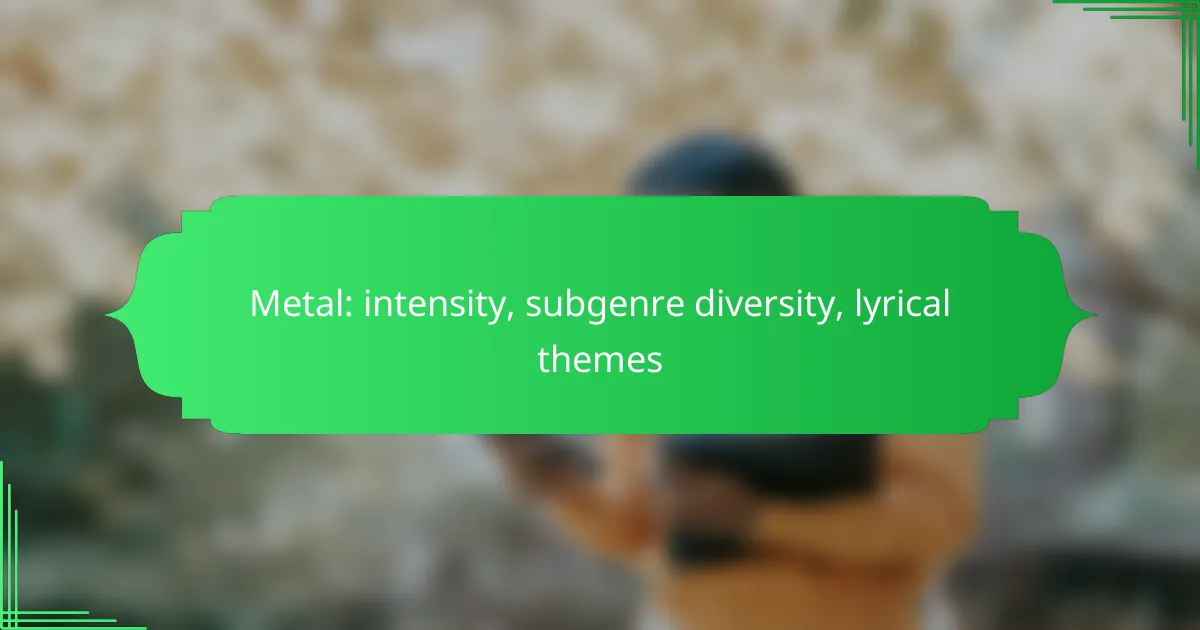Metal music is renowned for its intense sound, which varies widely across its numerous subgenres, each offering a unique listening experience. From the aggressive energy of thrash metal to the heavy, somber tones of doom metal, the diversity in intensity and instrumentation caters to a broad spectrum of listeners. Lyrically, metal delves into profound themes such as personal struggles, fantasy, and social commentary, showcasing the genre’s emotional depth and cultural significance.
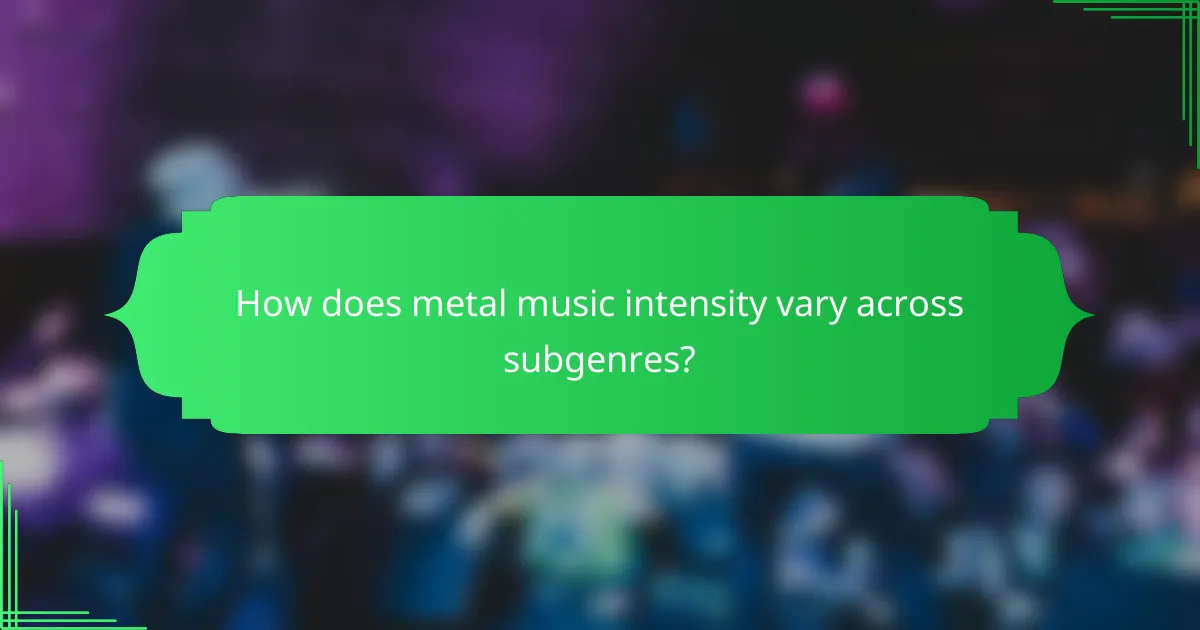
How does metal music intensity vary across subgenres?
Metal music intensity differs significantly across its various subgenres, influencing the overall listening experience. While some subgenres like thrash metal are characterized by high energy and aggression, others such as doom metal offer a more subdued and heavy atmosphere.
High intensity in thrash metal
Thrash metal is known for its fast tempos, aggressive guitar riffs, and powerful drumming, resulting in a high-intensity sound. Bands like Metallica and Slayer exemplify this subgenre, often featuring rapid-fire lyrics and complex song structures that keep listeners engaged and energized.
The intensity in thrash metal is typically marked by a tempo range of 120 to 200 beats per minute, creating an adrenaline-fueled experience. This subgenre often appeals to fans seeking a visceral reaction through music, making it a staple in live performances.
Moderate intensity in progressive metal
Progressive metal strikes a balance between intensity and complexity, often incorporating intricate musical arrangements and varied time signatures. Bands like Dream Theater and Opeth showcase this moderate intensity, blending heavy riffs with melodic passages and thoughtful lyrics.
The tempo in progressive metal can vary widely, usually ranging from 70 to 180 beats per minute, allowing for both heavy and softer moments. This subgenre often invites listeners to appreciate the musicianship and storytelling, making it suitable for those who enjoy a more cerebral approach to metal.
Low intensity in doom metal
Doom metal is characterized by its slow tempos, heavy guitar tones, and a generally dark atmosphere, resulting in low intensity compared to other metal subgenres. Bands like Black Sabbath and Candlemass exemplify this style, often focusing on themes of despair and existential dread.
The typical tempo in doom metal ranges from 40 to 80 beats per minute, creating a heavy, dragging sound that emphasizes mood over aggression. This subgenre appeals to listeners who appreciate a more reflective and immersive experience, often using lengthy compositions to build tension and atmosphere.

What are the main subgenres of metal music?
The main subgenres of metal music include heavy metal, black metal, death metal, and many others, each with distinct characteristics and themes. These subgenres vary in intensity, instrumentation, and lyrical content, appealing to different audiences and tastes within the metal community.
Heavy metal origins
Heavy metal originated in the late 1960s and early 1970s, primarily in the United Kingdom and the United States. Bands like Black Sabbath, Led Zeppelin, and Deep Purple are often credited as pioneers, combining blues rock with heavier guitar riffs and powerful vocals.
This genre laid the groundwork for many subgenres, emphasizing loud, distorted guitars, emphatic rhythms, and themes often centered around rebellion, fantasy, and mythology. The sound evolved throughout the 1970s and 1980s, leading to the emergence of various styles and bands.
Characteristics of black metal
Black metal is known for its raw sound, high-pitched shrieking vocals, and fast tempos. It often features tremolo-picked guitar riffs and blast beat drumming, creating an intense auditory experience. The genre typically embraces themes of darkness, nature, and anti-religion.
Visually, black metal is characterized by its use of corpse paint and dark, often theatrical imagery. Bands like Mayhem and Burzum have been influential, pushing the boundaries of both music and performance art within the genre.
Features of death metal
Death metal is distinguished by its heavily distorted guitars, deep growling vocals, and complex song structures. It often incorporates intricate guitar solos and varied tempos, creating a dynamic listening experience. Lyrically, death metal frequently explores themes of mortality, violence, and existentialism.
Notable bands such as Death and Cannibal Corpse have shaped the genre, pushing technical boundaries and establishing a dedicated fan base. The genre’s intensity and complexity often appeal to listeners who appreciate musical virtuosity and darker lyrical content.

What lyrical themes are common in metal music?
Metal music often explores intense and diverse lyrical themes, ranging from personal struggles to grand narratives. Common themes include darkness, fantasy, and social commentary, each reflecting the genre’s emotional depth and cultural relevance.
Dark themes in gothic metal
Gothic metal frequently delves into dark themes such as death, despair, and the supernatural. Lyrics often evoke a sense of melancholy, exploring human emotions and existential questions through a haunting lens. Bands like Paradise Lost and Type O Negative exemplify this with their poetic and somber storytelling.
The use of atmospheric instrumentation complements these themes, creating a rich soundscape that enhances the lyrical content. Imagery of darkness and the macabre is prevalent, appealing to listeners who appreciate the genre’s emotional intensity.
Fantasy elements in power metal
Power metal is characterized by its incorporation of fantasy elements, often drawing inspiration from mythology, epic tales, and heroic quests. Lyrics typically celebrate themes of valor, adventure, and triumph, inviting listeners into fantastical realms. Bands like Blind Guardian and DragonForce are known for their storytelling prowess in this subgenre.
The vivid imagery and grand narratives create an uplifting experience, contrasting with the darker themes found in other metal genres. This escapism is a key attraction for fans, who enjoy the blend of powerful music and imaginative storytelling.
Social issues in thrash metal
Thrash metal often addresses pressing social issues, including political corruption, war, and inequality. The aggressive sound of thrash complements its confrontational lyrics, making a bold statement about societal problems. Bands like Metallica and Slayer have tackled these themes, resonating with audiences who seek both intensity and substance in their music.
These lyrics serve as a form of protest, encouraging listeners to reflect on the world around them. The combination of fast tempos and thought-provoking content makes thrash metal a powerful vehicle for social commentary.
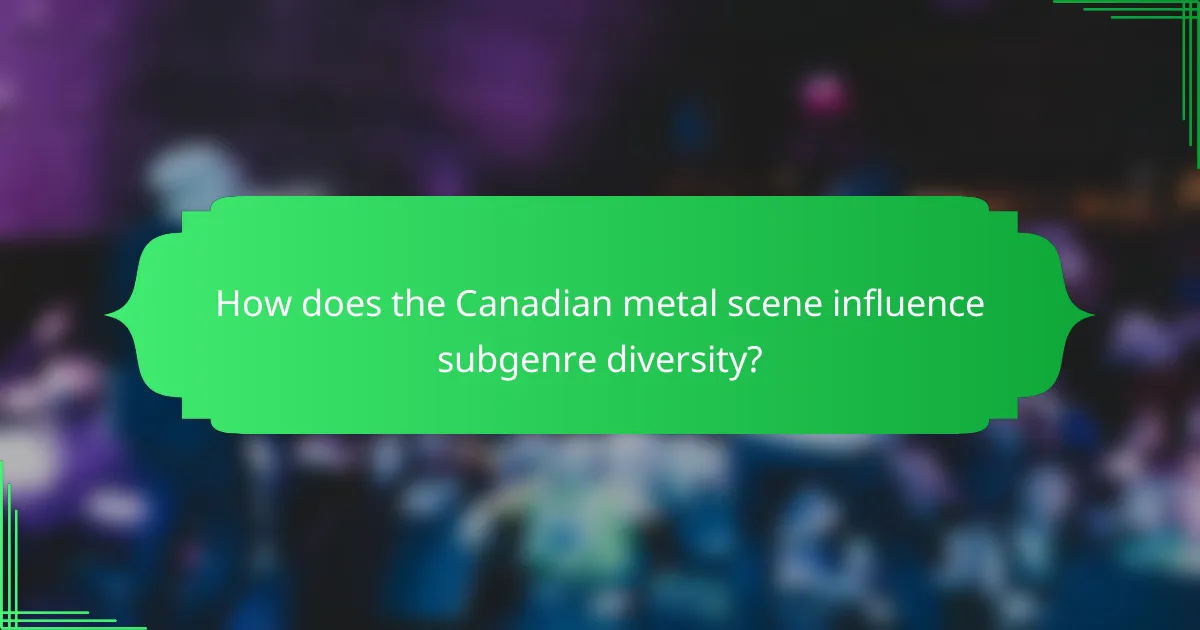
How does the Canadian metal scene influence subgenre diversity?
The Canadian metal scene significantly contributes to subgenre diversity by fostering a unique blend of styles and influences. This diversity is shaped by the country’s varied cultural backgrounds, geography, and musical traditions, allowing for innovative expressions within the metal genre.
Emergence of Canadian black metal
Canadian black metal has gained recognition for its atmospheric and raw sound, often reflecting the country’s vast wilderness and harsh climates. Bands like Blasphemy and Woods of Ypres have pioneered this subgenre, incorporating elements of traditional black metal while infusing local themes and narratives.
The scene is characterized by a DIY ethos, with many bands self-producing their music and organizing underground shows. This grassroots approach has led to a tight-knit community that encourages experimentation and collaboration among artists.
Impact of Canadian death metal bands
Canadian death metal bands have played a crucial role in shaping the global death metal landscape, known for their technical proficiency and brutal sound. Groups like Cryptopsy and Gorguts have pushed the boundaries of the genre, introducing complex song structures and innovative techniques.
The influence of Canadian death metal extends beyond music, as these bands often explore themes of existentialism, horror, and societal issues in their lyrics. This thematic depth, combined with their musical prowess, has helped establish Canada as a significant player in the death metal subgenre.
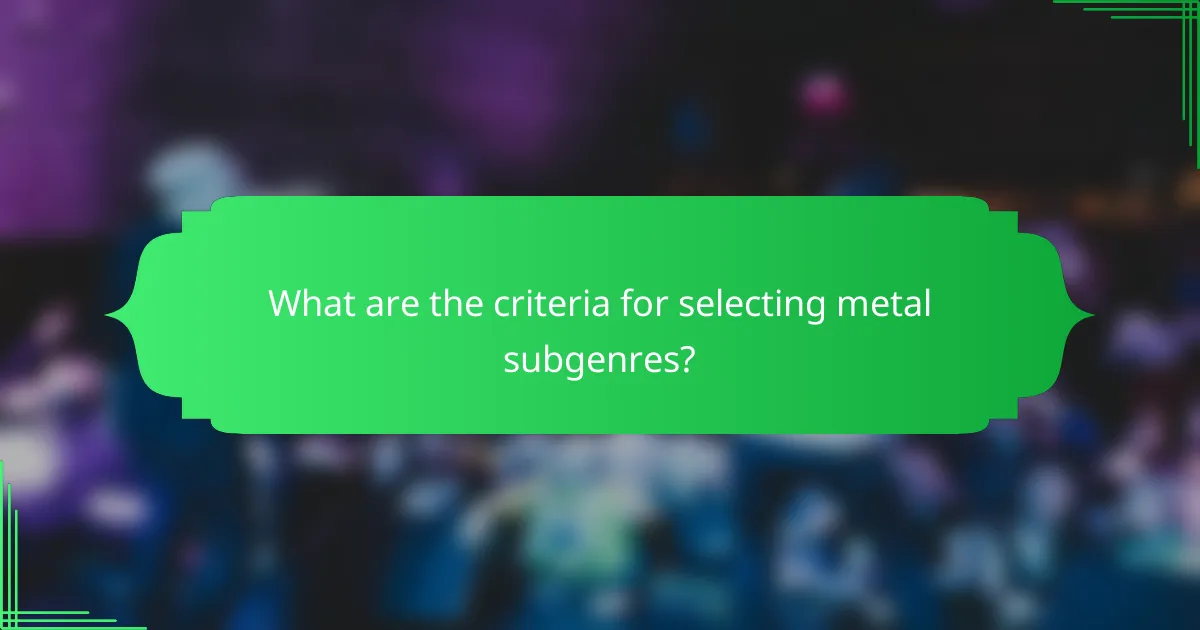
What are the criteria for selecting metal subgenres?
Selecting metal subgenres involves evaluating key criteria such as musical complexity, vocal styles, and instrumentation. Each of these elements contributes to the distinct sound and identity of a subgenre, influencing how it is categorized and appreciated by fans.
Musical complexity
Musical complexity in metal can vary widely, with some subgenres emphasizing intricate compositions and others favoring straightforward structures. For instance, progressive metal often features complex time signatures and extended song lengths, while punk metal tends to be more direct and aggressive. When selecting a subgenre, consider how the complexity aligns with your musical preferences.
Additionally, the use of unconventional scales and harmonies can enhance the complexity of a metal piece. Bands like Dream Theater exemplify this with their elaborate arrangements, while simpler forms like thrash metal focus on speed and aggression, appealing to different listener tastes.
Vocal styles
Vocal styles in metal range from melodic singing to harsh growls and screams, significantly impacting the genre’s identity. Subgenres like power metal often feature clean, soaring vocals, while death metal is characterized by guttural growls. Understanding these vocal techniques can help you appreciate the emotional and thematic depth of each subgenre.
When exploring vocal styles, consider the lyrical themes that often accompany them. For example, black metal’s shrieking vocals frequently convey dark and atmospheric narratives, while metalcore blends melodic and harsh vocals to express a mix of emotions, appealing to a broader audience.
Instrumentation
Instrumentation is a critical factor in defining metal subgenres, with variations in guitar, bass, drums, and keyboard usage. Traditional heavy metal typically features electric guitars, bass, and drums, while subgenres like symphonic metal incorporate orchestral instruments for a richer sound. This diversity in instrumentation allows for unique sonic experiences across the metal spectrum.
Moreover, the choice of guitar techniques, such as palm muting or sweep picking, can further distinguish subgenres. For example, technical death metal often showcases intricate guitar solos and complex drumming patterns, while stoner metal leans towards slower tempos and heavy riffs. Understanding these instrumental characteristics can enhance your appreciation of the genre’s diversity.
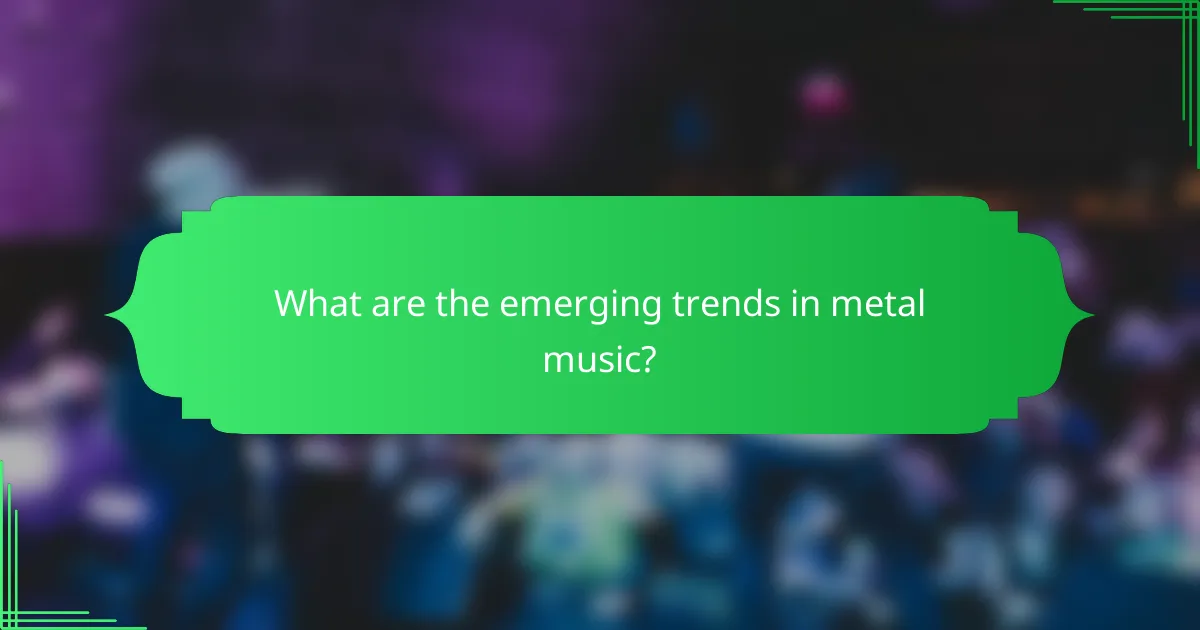
What are the emerging trends in metal music?
Emerging trends in metal music reflect a dynamic evolution, showcasing a blend of diverse influences, increased representation, and innovative soundscapes. These trends highlight the genre’s adaptability and its ability to resonate with a broader audience.
Fusion of genres
The fusion of metal with other genres is becoming increasingly prevalent, resulting in unique subgenres that attract a wider audience. Styles like metalcore, which combines elements of hardcore punk, and progressive metal, which incorporates jazz and classical influences, are examples of this trend.
Artists are experimenting with blending metal with genres such as hip-hop, pop, and even country, creating fresh sounds. This cross-pollination not only expands the listener base but also encourages creativity within the metal community.
Rise of female-fronted bands
There is a notable rise in female-fronted metal bands, breaking traditional gender norms within the genre. Bands like Arch Enemy and Nightwish have gained significant recognition, showcasing powerful female vocalists who bring a new perspective to metal music.
This trend is fostering a more inclusive environment, encouraging more women to participate in metal, both as performers and fans. The visibility of female artists is reshaping the narrative around metal, promoting diversity and representation.
Incorporation of electronic elements
The incorporation of electronic elements into metal is reshaping the soundscape of the genre. Many bands are integrating synthesizers, samples, and digital effects to create a more layered and atmospheric sound, appealing to fans of both metal and electronic music.
This trend can be seen in genres like industrial metal and electronicore, where the boundaries between metal and electronic music blur. Artists are encouraged to experiment with technology, leading to innovative compositions that push the limits of traditional metal.
